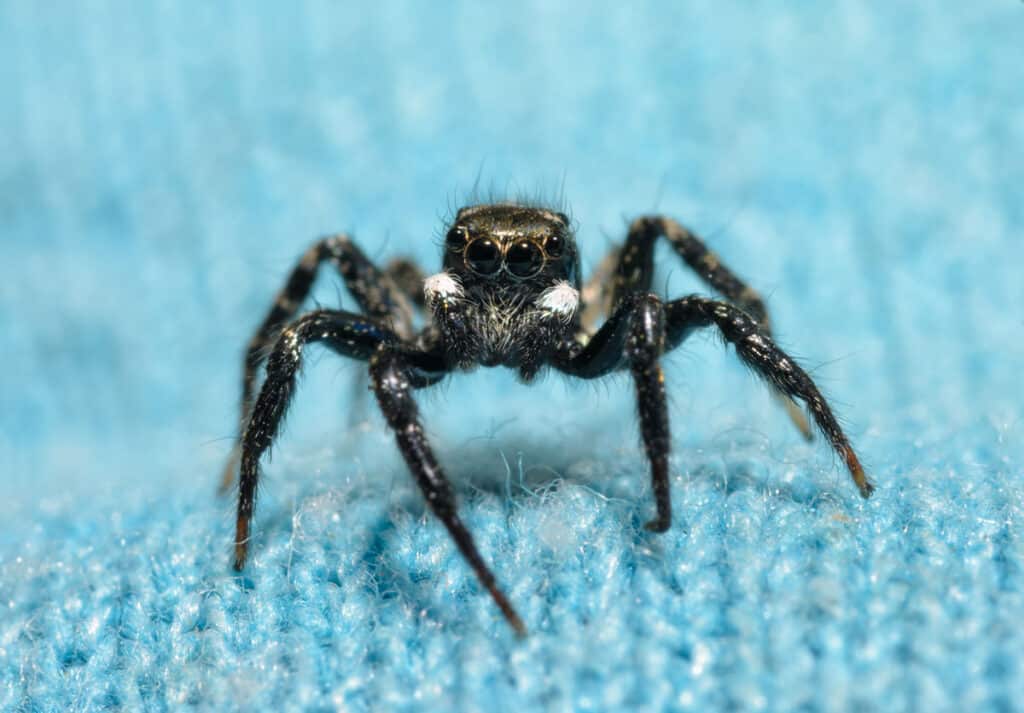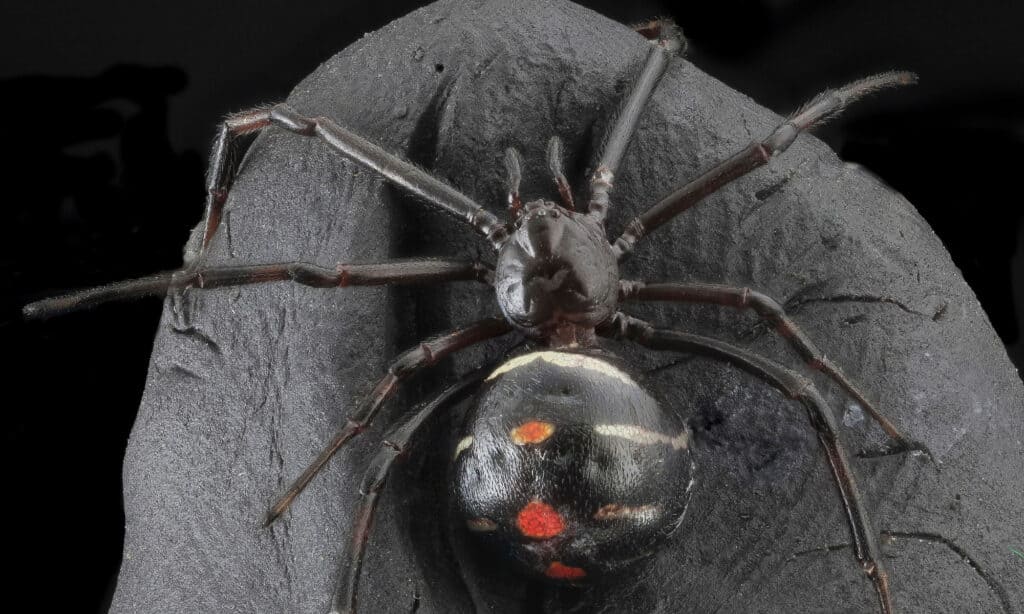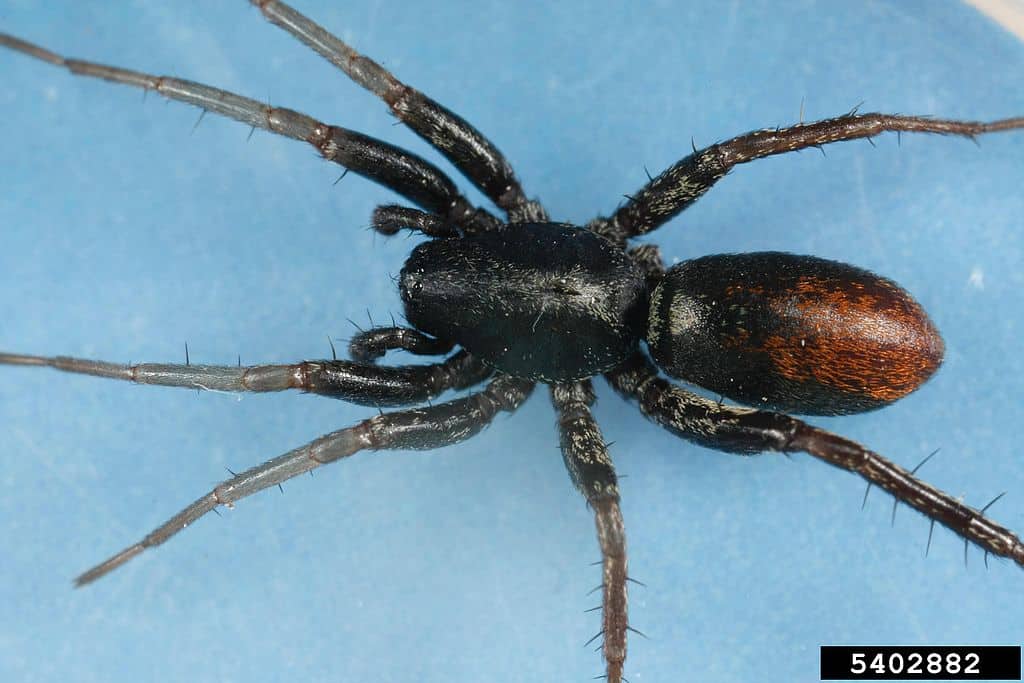
Mississippi is a state known for its rich history, beautiful landscapes, and diverse wildlife. It is home to many fascinating creatures, including one that strikes fear in the hearts of many: the black spider. With their distinctive black bodies, eight spindly legs, and ominous presence, these spiders are a common sight across the state. While some may view them as a mere nuisance, others see them as a source of terror!
This article will explore the world of black spiders in Mississippi. We delve into their unique characteristics, habits, and the myths and misconceptions surrounding them.
Twin-Flagged Jumping Spider (Anasaitis canosa)

Their setae contribute to the formation of the spider’s distinct “flags.”
©Sari ONeal/Shutterstock.com
This spider species in Mississippi belonging to the genus Anasaitis is recognizable by its twin-flagged feature. It possesses shimmering setae, or hairs, that can display shades of white, green, or pink. These setae contribute to the formation of the spider’s distinct “flags.” They also add to the design of patches on the male pedipalps. The patches serve a purpose in courtship and intraspecific communication among individuals of the same species.
Adult twin-flagged jumping spiders typically measure between 0.15 to 0.4 inches in length.
Similar to other Salticids, this particular species utilizes its silk to create a tether while making jumps. In case of a failed attempt, the spider can climb back up its silk to return to its previous position.
Twin-flagged jumping spiders are diurnal and primarily hunt insects such as flies or beetles, as well as other spiders. Occasionally, some of these jumping spiders might find their way inside homes. They tend to conceal themselves under furniture, in floor crevices, door trim, or between boxes and books.
Jumping spiders tend to be quite timid and often flee or leap away when humans come near. Moreover, their venom is not hazardous to humans. The amount they can administer is typically too small to cause harm.
Fun Facts
- These spiders take a direct approach when hunting, pouncing and puncturing from any direction.
- This spider species does not rely on web-building as a means of capturing food.
- Despite its small size, this jumping spider is incredibly fast and can be quite entertaining.
Northern Black Widow (Latrodectus variolus)

On its ventral surface, there is a red hourglass shape that appears to be broken or split.
©Porco_Rosso/Shutterstock.com
In Mississippi, two types of black widow spiders can be found, both possessing a venomous bite.
The northern black widow spider has a shiny black abdomen with prominent red circles on its dorsal surface. On its ventral surface, there is a red hourglass shape that appears to be broken or split. It is crucial to note the separation of the hourglass, as it distinguishes it from the southern black widow. The southern black widow has a solid, uninterrupted hourglass marking. The adults range from 0.15 to 0.43 inches, with males being approximately half the size of females.
This spider is known to be elusive and tends to avoid confrontation by attempting to conceal itself. However, if it feels intimidated or endangered, it may bite in self-defense. This can occur when someone inadvertently disturbs its habitat, such as by abruptly flipping over a log or rock.
It is possible to find northern black widow spiders in neglected outbuildings, greenhouses, garages, or storage areas. These spiders utilize their webs to capture a variety of prey, including flies, caterpillars, grasshoppers, mosquitoes, and beetles.
The venom of both female black widow spider species is poisonous. However, the northern black widow’s venom is less potent (though this is up for debate!). A bite victim may experience initial pain at the site of the bite, subsequent severe systemic pain, and abdominal cramps.
Fun Facts
- These spiders build webs in an unorganized manner and hang inside them in inverted positions.
- These spiders are primarily active at night, so sightings of them are relatively infrequent.
- Only females of this species are venomous.
Southern Black Widow (Latrodectus mactans)

It is worth noting that the size of southern black widows can vary significantly within different populations.
©Jeff W. Jarrett/Shutterstock.com
Arguably, the most venomous spider in Mississippi is the southern black widow.
A shiny black body characterizes the appearance of a southern black widow spider with red markings. Females have a body comprised of two sections – the cephalothorax and the abdomen. On the underside of the abdomen, there is typically a red hourglass-shaped mark. However, it may be small in size or missing entirely. Some specimens may have a single red spot located just behind the spinnerets. Others may display a row of red markings along the back.
It is worth noting that the size of southern black widows can vary significantly within different populations. Females typically measure about 3/8 inch in length, while males are typically smaller at about 3/16 inch.
The juvenile of the southern black widow exhibits a distinct appearance with a combination of orange and white coloration. As they progress through their developmental stages, their coloration gradually shifts to a darker shade of black.
Southern black widows have a varied diet and consume a wide range of arthropods. They are known to prey heavily on red imported fire ants. They also feed on numerous other types of insects. These spiders are often found in a variety of habitats, including houses, outhouses, cotton fields, and trash heaps.
The venom of the southern black widow spider is known to affect the nervous system of its victims. Although some people may only encounter mild symptoms, others, especially children, may experience a severe, life-threatening reaction to the venom.
Fun Facts
- There are over 25 species of Latrodectus found worldwide.
- 10 to 14 days after emerging from their eggs, these spiders may exhibit highly cannibalistic behavior.
- The southern black widow spider usually mates during the spring and summer months.
Bold Jumping Spider (Phidippus audax)

One of the most distinguishing features of these spiders is their unique eye arrangement.
©Mircea Costina/Shutterstock.com
Mississippi is home to various species of jumping spiders, including the bold jumping spider, also called the daring jumping spider. These spiders have a predominantly black body, with notable white or red spots on the top of their back. They are covered in hair and have robust physiques.
One of the most distinguishing features of these spiders is their unique eye arrangement. The front row consists of four eyes, with the middle pair being significantly larger than the others. The second and third rows of eyes are situated farther back on their cephalothorax.
Fully grown bold jumping spiders typically measure between 0.5 to 0.8 inches in length.
During the winter, the bold jumping spider resides as subadults, and when spring arrives, they reach maturity and mate. In the summer, they produce egg sacs that they hide under the bark of logs.
Their diet mainly consists of insects, and they have been known to consume nectar occasionally. They are commonly found in grasslands and prairies. The bold jumping spider can also be seen in old fields, gardens, open woodland areas, and even inside homes.
Bold jumping spiders are known to be shy creatures and tend to retreat when approached by humans. They rarely bite when handled. In such cases, their bites typically cause only minor symptoms such as itching, pain, redness, and swelling. These symptoms usually subside within a couple of days.
Fun Facts
- Unlike several other hunting spiders, the bold jumping spider hunts its prey during daylight hours.
- They are known to be effective predators of numerous crop pests.
- The juveniles of this species exhibit orange abdominal spots that turn white as they mature.
Red Spotted Ant Mimic Spider (Castianeira descripta)

This spider sports a sleek black body and reddish-brown abdomen. It is characterized by its shiny, hairy legs.
©Joseph Berger, Bugwood.org; University of Georgia / CC BY 3.0, via Wikimedia Commons – License
The state of Mississippi is home to a fascinating species. This spider, the red spotted ant mimic, is known for its remarkable hunting abilities. This particular arachnid has earned its name due to its uncanny resemblance and behavior to ants.
This spider sports a sleek black body and reddish-brown abdomen. It is characterized by its shiny, hairy legs and a distinctive white line down the center of its carapace.
While females generally grow up to half an inch in length, their male counterparts tend to be smaller in size.
It chooses to hunt by wandering around in search of food instead of relying on web-based traps. The red-spotted ant mimic spider’s diet mainly consists of ants and small insects. As for their habitat, they can be found dwelling in various locations, including woods, parks, shrubs, and under stones.
Their venom is only harmful to small prey and does not pose a huge threat to humans. However, if provoked, they may bite, and the resulting sensation is similar to that of a bee sting.
Fun Facts
- The spider mimics ant behavior to get closer to its prey before attacking.
- They construct silken sacs in close proximity to ant colonies for their resting place.
- Spiderlings are independent as soon as they hatch from their eggs.
Black and Yellow Garden Spider (Argiope aurantia)

Black and yellow garden spiders prefer to spin their webs in sunny locations that offer support from nearby plants.
©iStock.com/AwakenedEye
In Mississippi, the orb-weaving spider known as Argiope aurantia is widely recognized. It is referred to as the black and yellow garden spider due to its distinctive appearance.
These spiders possess a unique adaptation to help them spin intricate webs: an additional claw. Unlike most spiders that have only two claws on each foot, orb weavers have an extra claw. Females have a striking appearance, with black topsides on their abdomens and symmetrically arranged bright yellow patches.
Males, on the other hand, have less vibrant features, with less yellow coloration on their abdomens and brownish legs. The size difference between the sexes is also notable. Females average 0.75 to 1 inch in body length, up to three times larger than their male counterparts.
Black and yellow garden spiders prefer to spin their webs in sunny locations that offer support from nearby plants. As a result, they can often be found in backyard gardens. These spiders have an opportunistic diet and will consume any prey caught in their web, provided it doesn’t break free. Interestingly, female spiders will eat the sticky strands of their webs at night and then proceed to spin new ones.
Their venom is not harmful to humans but plays a crucial role in immobilizing their prey. Flying insects such as flies and bees are commonly caught in the web, and the spider’s venom helps to subdue them.
Fun Facts
- Black and yellow garden spiders are beneficial to humans and gardens as they prey on pests.
- Jumping spiders commonly prey on young black and yellow garden spiders.
- Their eggs are round in shape and can vary in color from white to light brown.
The photo featured at the top of this post is © Miles Boyer/Shutterstock.com
Thank you for reading! Have some feedback for us? Contact the AZ Animals editorial team.






